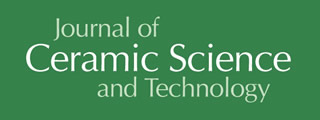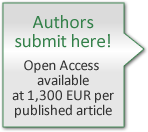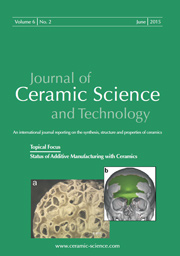Articles
All articles | Recent articles
Novel Cement-Ceramic Encapsulation Material for Electronic Packaging
S. Kaessner1,2, N. Wichtner1, F. Hueller3, C. Berthold1, K. G. Nickel1
1 University of Tuebingen, Geosciences, Applied Mineralogy, D-72074 Tuebingen, Germany
2 Robert Bosch GmbH, Corporate Sector Research and Advance Engineering, D-71272 Renningen, Germany
3 Friedrich-Alexander University Erlangen-Nuernberg (FAU), GeoZentrum Nordbayern, Mineralogy, D-91054 Erlangen, Germany
received March 12, 2018, received in revised form April 16, 2018, accepted May 29, 2018
Vol. 9, No. 4, Pages 381-390 DOI: 10.4416/JCST2018-00024
Abstract
Future power electronic devices with high power density and reduced chip area need robust encapsulation materials with increased thermal conductivity and temperature stability. Especially for new SiC and GaN semiconductor technology, operating temperatures above 200 °C can increase the potential of future power electronics. This paper introduces a novel uniquely processed cement-ceramic composite material for electronic packaging, containing a calcium aluminate cement (CAC) matrix and high amounts of alumina fillers. In-situ µ-XRD²-DTA, where X-ray diffraction patterns and DTA traces can be monitored simultaneously, was applied to investigate the dehydration behavior of this composite between room temperature and 300 °C for the first time. The results reveal the high potential of using in-situ µ-XRD²-DTA for measurements on cement-ceramic composites. The observed microstructure evolution shows micro-crack formation and increased porosity above 210 °C, which can be correlated with the dehydration of gibbsite and katoite. At this stage, the novel cement-ceramic encapsulation material already enables miniaturized passive electronic components. Further consequences for electronic packaging of semiconductors and correlations to state-of-the-art encapsulation materials are discussed.
![]() Download Full Article (PDF)
Download Full Article (PDF)
Keywords
Cement-ceramic encapsulation, CAC, processing, dehydration, electronic packaging
References
1 Ohara, K., Masumoto, H., Takahashi, T., Matsumoto, M., Otsubo, Y.: A New IGBT Module with Insulated Metal Baseplate (IMB) and 7th Generation Chips. In: Proceedings of PCIM Europe 2015. Nuremberg, Germany, 2015.
2 Asada, S., Kondo, S., Kaji, Y., Yoshida, H.: Resin Encapsulation Combined with Insulated Metal Baseplate for Improving Power Module Reliability. In: PCIM Europe 2016. Nuremberg, Germany, 2016.
3 Stosur, M., Sowa, K., Piasecki, W., et al.: Encapsulation of power electronics components for operation in harsh environments, Arch. Electr. Eng., 66, [4], 855 – 866, (2017).
4 Yao, Y., Lu, G.-Q., Chen, Z., Boroyevich, D., Ngo, K.D.T.: Assessment of encapsulants for high-voltage, high-temperature power electronic packaging. In: IEEE Electric Ship Technologies Symposium (ESTS). Alexandria, Virginia, USA, 2011.
5 Parr, C., Simonin, F., Touzo, B., Wohrmeyer, C., Valdelièvre, B., et al.: Impact of calcium aluminate cement hydration upon the properties of refractory castables, J. Tech. Assoc. Refract., 25, 78 – 88, (2005).
6 Pöllmann, H.: Calcium aluminate cements - raw materials, differences, hydration and properties, Rev. Mineral. Geochem., 74, [1], 1 – 82, (2012).
7 Seligmann, P., Greening, N.R.: New techniques for temperature and humidity control in X-ray diffractometry, J. PCA Res. Dev. Lab. 4, PCA Res. Dept. Bull., 143, 2 – 9, (1962).
8 Jones, F.E., Roberts, M.H.: The System CaO-Al2O3-H2O at 25 °C (en), Build. Res. Stat., Current Paper Res. Ser. 1, 27, (1962).
9 Smolczyk, H.-G.: Evaluating CAC concrete with X-ray analysis, in german, Betonstein-Ztg., 30, 573 – 579, (1964).
10 Mishima, K.: Relation between the Hydration of Alumina Cement Mortars and their Strength in the Early Ages. In: 5th International Congress on the Chemistry of Cement, Tokyo, Japan, 1968.
11 Locher, F.W.: Cement: Principles of production and use, in German, Verl. Bau und Technik, Düsseldorf, 2000.
12 Wang, Y., Li, X., Zhu, B., Chen, P.: Microstructure evolution during the heating process and its effect on the elastic properties of CAC-bonded alumina castables, Ceram. Int., 42, 11355 – 11362, (2016).
13 Han, B., Wang, P., Ke, C., Yan, W., Wei, Y., et al.: Hydration behavior of spinel containing high alumina cement from high titania blast furnace slag, Cement Concrete Res., 79, 257 – 264, (2016).
14 Maaroufi, M.-A., Lecomte, A., Diliberto, C., Francy, O., Le Brun, P.: Thermo-hydrous behavior of hardened cement paste based on calcium aluminate cement, J. Eur. Ceram. Soc., 35, 1637 – 1646, (2015).
15 Lee, W.E., Vieira, W., Zhang, S., Ahari, K.G., Sarpoolaky, H., et al.: Castable refractory concretes, Int. Mater. Rev., 46, 145 – 167, (2001).
16 Klaus, S.: Quantification of CA hydration and influence of its particle fineness during early hydration of calcium aluminate cement, Dissertation, University of Erlangen-Nuremberg, Erlangen, Germany, 2015.
17 Goetz-Neunhoeffer, F.: Models for the hydration kinetics of calcium aluminate cement with calcium sulfate from a crystal-chemical and mineralogical point of view, in German, Erlanger Forschungen/Reihe B, Naturwissenschaften und Medizin, Erlangen, Germany, 2006.
18 Berthold, C., Presser, V., Huber, N., Nickel, K.G.: 1 + 1 = 3: coupling μ-XRD2 and DTA, new insights in temperature-dependent phase transitions, J. Therm. Anal. Calorim., 103, 917 – 923, (2011).
19 O'Connor, B.H., Raven, M.D.: Application of the rietveld refinement procedure in assaying powdered mixtures, Powder Diffr., 3, 2 – 6, (1988).
20 Jansen, D., Goetz-Neunhoeffer, F., Stabler, C., Neubauer, J.: A remastered external standard method applied to the quantification of early OPC hydration, Cement Concrete Res., 41, 602 – 608, (2011).
21 Funk, J.E., Dinger, D.R.: Predictive Process Control of Crowded Particulate Suspensions: Applied to Ceramic Manufacturing. Springer US, Boston, USA, 1994.
22 Telle, R., Salmang, H., Scholze, H.: Keramik: Mit 132 Tabellen (Ceramics: With 132 tables). 7th ed., Springer, Berlin, Heidelberg, New York, 260, 2007.
23 Reichling, K.: Determination and evaluation of the electrical concrete resistivity using geophysical methods, in German, 1st ed. Beuth Verlag GmbH, Berlin, 2015.
24 Wilkosz, D.E., Young, J.F.: Effect of moisture adsorption on the electrical properties of hardened portland cement compacts, J. Am. Ceram. Soc., 78, 1673 – 1679, (1995).
25 Rouquerol, J., Rouquerol, F., Ganteaume, M.: Thermal decomposition of gibbsite under low pressures. II. formation of microporous alumina, J. Catal., 57, 222 – 230, (1979).
26 Newman, J., Choo, B.S.: Advanced Concrete Technology 1: Constituent Materials. 1st ed. Elsevier Professional, 2/9, 2003.
27 Saalfeld, H.: Structures of hydrargillite and the intermediate phases during dehydration, in German, N. Jb. Mineral. Abh., 95, 1 – 87, (1960).
28 IPC-TM-650, 2.6.3.3: Surface Insulation resistance, fluxes, International Standard, 2004
29 IEC 60747 – 9:2007: Semiconductor devices - Discrete devices – Part 9: Insulated-gate bipolar transistors (IGBTs), International standard, VDE Verlag, 2007.
30 IEC 60749 – 5:2017: Semiconductor devices - Mechanical and climatic test methods - Part 5: Steady-state temperature humidity bias life test, International Standard, VDE Verlag, 2017.
31 ZVEI LV324: Qualification of power electronic modules for components of motor vehicles, Edition 2014 – 02.
Copyright
Göller Verlag GmbH


